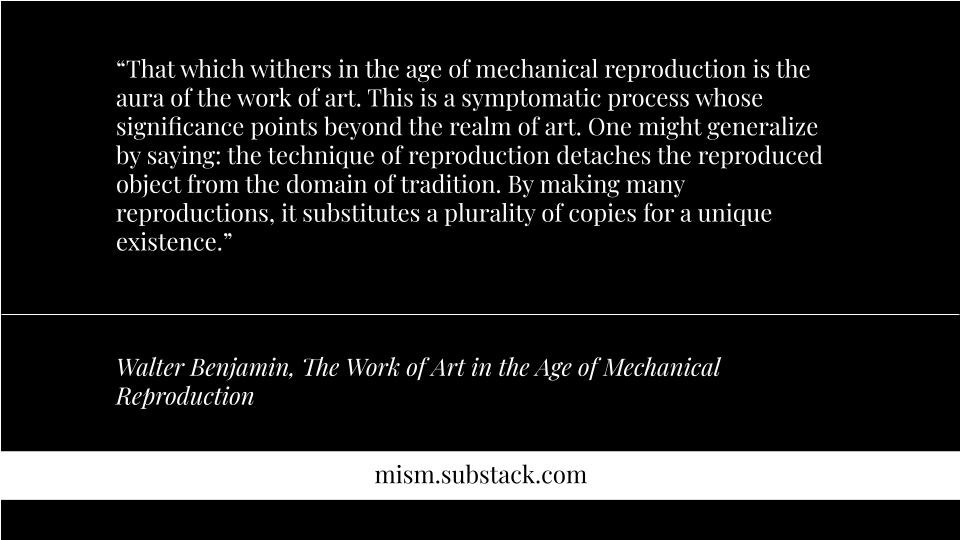I started my Readings on Resistance with a brief re-examination of digital idolatry. Here, I continue with a few reflections on what is lost when human attention turns to idol worship. The source for this inquiry is Walter Benjamin’s The Work of Art in the Age of Mechanical Reproduction.
The epigraph to this essay comes from a poetic mind attuned to the experience of this ineffable loss. Paul Valéry writes about a “physical component” in all the arts “which can no longer be considered or treated as it used to be.”
“Our fine arts were developed, their types and uses were established, in times very different from the present, by men whose power of action upon things was insignificant in comparison with ours. But the amazing growth of our techniques, the adaptability and precision they have attained, the ideas and habits they are creating, make it a certainty that profound changes are impending in the ancient craft of the Beautiful. In all the arts there is a physical component which can no longer be considered or treated as it used to be, which cannot remain unaffected by our modern knowledge and power. For the last twenty years neither matter nor space nor time has been what it was from time immemorial. We must expect great innovations to transform the entire technique of the arts, thereby affecting artistic invention itself and perhaps even bringing about an amazing change in our very notion of art.”
— Paul Valéry, PIÈCES SUR L’ART “Le Conquete de l’ubiquité,” Paris.
What Valery calls the physical component seems closely related to Benjamin’s idea of aura, which is what works of art lose in the age of mechanical reproduction. On page 4, Benjamin writes:
The authenticity of a thing is the essence of all that is transmissible from its beginning, ranging from its substantive duration to its testimony to the history which it has experienced. Since the historical testimony rests on the authenticity, the former, too, is jeopardized by reproduction when substantive duration ceases to matter. And what is really jeopardized when the historical testimony is affected is the authority of the object.
One might subsume the eliminated element in the term “aura” and go on to say: that which withers in the age of mechanical reproduction is the aura of the work of art. This is a symptomatic process whose significance points beyond the realm of art. One might generalize by saying: the technique of reproduction detaches the reproduced object from the domain of tradition. By making many reproductions, it substitutes a plurality of copies for a unique existence.
The loss of aura is not a bug but a feature of mechanical reproduction, and it doesn’t just affect works of art; it affects all human beings, including the artist and the patron.
With this perspective in mind, I think of our devotion to devices, particularly the devices we call “smart phones”, as portals to realms of mechanically reproduced objects detached from their own history. Through this devotion, we are absorbed into worlds we can’t properly regard as our own. The more we inhabit these worlds, the less equipped we are to resist the enclosure of the human psyche.
In my view, the age of mechanical reproduction didn’t begin either with smart phones, or the internet, or photography. Through my recent readings, I’ve traced the beginning of this age all the way to the invention of the phonetic alphabet and the creation of graven images to substitute for the word of the living God.
These developments represent two early forms of disconnection from reality. Idol worship fueled the age of mechanical reproduction not because of the mechanics of idol creation, but because of the underlying principle of substitution. Similarly, the phonetic alphabet decoupled sound from meaning, and it codified the spoken word into a system of symbols. Suddenly, a living ephemeral expression tied to a specific time and place became reproducible across time and space. Detached from its original context, its aura diminished, the spoken word was lost in transcription.
We can study the loss of the real thing through countless perspectives, including the understanding of media and myth. The clearest obstacle to this understanding is the denial of the loss. As citizens of the technological society, engrossed in the story of our journey to the promised land, we can’t see ourselves as a bewildered mass worshipping the Black Mirror and the Golden Calf. Until we break the spell of denial, we remain Pharaoh’s slaves, intoxicated with the opium of the masses, hallucinating our progress toward a blissful life in the land flowing with milk and honey.
To receive further Readings on Resistance by email, subscribe, share and stay tuned.


